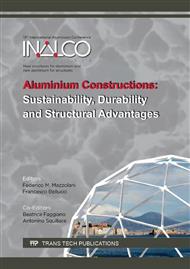[1]
W. Zhang , C. Wang , W. Liu, Characterization and tribological investigation of sol–gel ceramic films on Ti–6Al–4V, Wear 260 (2006) 379–386.
DOI: 10.1016/j.wear.2005.05.006
Google Scholar
[2]
Z. Cai, T. Shafer, I. Watanabe, M. E. Nunn, T. Okabe, Electrochemical characterization of cast titanium alloys, Biomaterials 24 (2003) 213-218.
DOI: 10.1016/s0142-9612(02)00293-4
Google Scholar
[3]
I. Gurappa, Characterization of different materials for corrosion résistance under simulated body fluid conditions, Materials Characterization 49 (2002) 73-79.
DOI: 10.1016/s1044-5803(02)00320-0
Google Scholar
[4]
H.H. Huang, T.H. Lee, Electrochemical impedance spectroscopy study Of Ti–6Al–4V alloy in artificial saliva with fluoride and/or bovine albumin, Dental Materials 21 (2005) 749–755.
DOI: 10.1016/j.dental.2005.01.009
Google Scholar
[5]
R.W. Wei Hsu, C.C. Yang, C.A. Huang, Y.S. Chen, Electrochemical corrosion properties of Ti–6Al–4V implant alloy in the biological environment, Materials Science and Engineering A 380 (2004)100–109.
DOI: 10.1016/j.msea.2004.03.069
Google Scholar
[6]
C.E.B. Marino, L.H. Mascaro, E.I.S. characterization of a Ti-dental implant in artificial saliva media- Dissolution process of the oxide barrier, Journal of Electroanalytical Chemistry 568 (2004) 115–120.
DOI: 10.1016/j.jelechem.2004.01.011
Google Scholar
[7]
I. Gurrappa, D.V. Reddy, Characterisation of titanium alloy, IMI-834 for corrosion resistance under different environmental conditions, Journal of Alloys and Compounds 390 (2005) 270–274.
DOI: 10.1016/j.jallcom.2004.08.040
Google Scholar
[8]
Y.Z. Huang, D.J. Blackwood, Characterisation of titanium oxide film grown in 0. 9% NaCl at different sweep rates , Electrochimica Acta 51 (2005) 1099–1107.
DOI: 10.1016/j.electacta.2005.05.051
Google Scholar
[9]
M.M. Khaled, B.S. Yilbas, I.Y. Al-Qaradawi, P.G. Coleman, D. Abdulmalik, Z.S. Seddigi, A. Abulkibash, B.F. Abu-Sharkh, M.M. Emad, Corrosion properties of duplex treated Ti–6Al–4V alloy in chloride media using electrochemical and positron annihilation spectroscopy techniques, Surface & Coatings Technology 201 (2006).
DOI: 10.1016/j.surfcoat.2006.01.019
Google Scholar
[10]
Y. Khelfaoui, M. Kerkar, A. Bali, F. Dalard, Electrochemical characterisation of a PVD film of titanium on AISI 316L stainless steel, Surface & Coatings Technology 200 (2006) 4523–4529.
DOI: 10.1016/j.surfcoat.2005.03.043
Google Scholar
[11]
K. Habib, Laser optical interferometry as NDT methods for cleaner and sustainable desalination plants pitting and crevice corrosion, Dessalination 166 (2004) 171-190.
DOI: 10.1016/j.desal.2004.06.072
Google Scholar
[12]
M. Li, S. Luo, P. Wu, J. Shen, Photocathodic protection effect of TiO2 films for carbon steel in 3% NaCl solutions, Electrochimica Acta 50 (2005) 3401–3406.
DOI: 10.1016/j.electacta.2004.12.031
Google Scholar
[13]
C. Monticelli, A. Frignani, A. Bellosi, G. Brunoro, G. Trabanelli, The corrosion behaviour of titanium diboride in neutral chloride solution, Corrosion Science 43 (2001) 979-992.
DOI: 10.1016/s0010-938x(00)00120-7
Google Scholar
[14]
E. Almeida, M.R. Costa, N.D. Cristofaro, N. Mora, R. Catala, J.M. Puente, J.M. Bastidas, Titanium passivated lacquered tinplate cans in contact with foods, Corrosion Engineering, Science and Technology 40 (2005) 2.
DOI: 10.1179/174327805x29859
Google Scholar
[15]
R. M. Souto, M. M. Laz, R. L. Reis, Degradation characteristics of hydroxyapatite coatings on orthopaedic TiAlV in simulated physiological media investigated y electrochemical impedance spectroscopy, Biomaterials 24 (2003) 4213–4221.
DOI: 10.1016/s0142-9612(03)00362-4
Google Scholar
[16]
C.M. Lin, S.K. Yen, Biomimetic growth of apatite on electrolytic TiO2 coatings in simulated body fluid, Materials Science and Engineering C 26 (2006) 54-64.
DOI: 10.1016/j.msec.2005.06.048
Google Scholar
[17]
B.S. Ng, I. Annergren, A.M. Soutar, K.A. Khor, A.E.W. Jarfors, Characterisation of a duplex TiO2/CaP coating on Ti6Al4V for hard tissue replacement, Biomaterials 26 (2005) 1087–1095.
DOI: 10.1016/j.biomaterials.2004.04.022
Google Scholar
[18]
C. Jaeggi, P. Kern, J. Michler, T. Zehnder, H. Siegenthaler, Anodic thin films on titanium used as masks for surface micropatterning of biomedical devices, Surface & Coatings Technology 200 (2005) 1913-(1919).
DOI: 10.1016/j.surfcoat.2005.08.021
Google Scholar
[19]
K. Azumi, N. Yasui, M. Seo, Changes in the properties of anodic oxide films formed on titanium during long-term immersion in desaerated neutral solutions, Corrosion Science 42 (2000) 885-896.
DOI: 10.1016/s0010-938x(99)00096-7
Google Scholar
[20]
J.P. Gueneau de Mussy, J.V. Macpherson, J.L. Delplancke, Characterisation and behaviour of Ti/TiO2/noble metal anodes, Electrochimica Acta 48 (2003) 1131-1141.
DOI: 10.1016/s0013-4686(02)00824-1
Google Scholar
[21]
W. Zhang, C. Wang, W. Liu, Characterization and tribological investigation of sol–gel ceramic films on Ti–6Al–4V, Wear 260 (2006)379–386.
DOI: 10.1016/j.wear.2005.05.006
Google Scholar
[22]
N.T.C. Oliveira, E.A. Ferreira, L.T. Duarte, S.R. Biaggio, R.C. R. Filho, N. Bocchi, Corrosion resistance of anodic oxides on the Ti–50Zr and Ti–13Nb–13Zr alloys, Electrochimica Acta 51 (2006) 2068-(2075).
DOI: 10.1016/j.electacta.2005.07.015
Google Scholar
[23]
A.W.E. Hodgson, Y. Mueller, D. Forster, S. Virtanen, Electrochemical characterisation of passive films on Ti alloys under simulated biological conditions, Electrochimica Acta 47 (2002) 1913-(1923).
DOI: 10.1016/s0013-4686(02)00029-4
Google Scholar
[24]
M. Karthega, V. Raman, N. Rajendran, Influence of potential on the electrochemical behaviour of β titanium alloys in Hank's solution, Acta Biomaterialia 3 (2007) 1019-1023.
DOI: 10.1016/j.actbio.2007.02.009
Google Scholar
[25]
A.K. Shukla, R. Balasubramaniam, S. Bhargava, Properties of passive film formed on CP titanium, Ti–6Al–4V and Ti–13. 4Al–29Nb alloys in simulated human body conditions, Intermetallics 13 (2005) 631–637.
DOI: 10.1016/j.intermet.2004.10.001
Google Scholar
[26]
D.J. Blackwood, S.K.M. Chooi, Stability of protective oxide films formed on a porous titanium, Corrosion Science 44 (2002) 395–405.
DOI: 10.1016/s0010-938x(01)00080-4
Google Scholar
[27]
E. P. Abellan, L. R. Sousa, W.D. Muller, A.C. Guastaldi, Electrochemical stability of anodic titanium oxide films grown at potentials higher than 3V in a simulated physiological solution, Corrosion Science 49 (2007) 1645–1655.
DOI: 10.1016/j.corsci.2006.08.010
Google Scholar
[28]
S. Virtanen , I. Milosev , E. Gomez-Barrena , R. Trebse , J. Salo , Y.T. Konttinen, Special modes of corrosion under physiological and simulated physiological conditions, Acta Biomaterialia 4 (2008) 468–476.
DOI: 10.1016/j.actbio.2007.12.003
Google Scholar
[29]
E. Nouicer, F- Zohra. Benlahreche, L. Yahia, M. Eutamene , H. Chadli, Effect of scan rates and imposed potentials on the formation and growth of oxide film on Ti6Al4V alloy surface in 3% NaCl, Revue de Métallurgie 108 (2011) 69-74.
DOI: 10.1051/metal/2011021
Google Scholar


